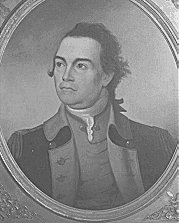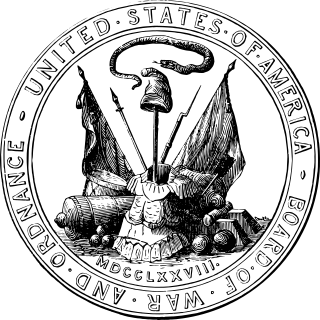
William Augustine Washington was a cavalry officer of the Continental Army during the American Revolutionary War, who held a final rank of Brigadier General in the newly created United States after the war. Primarily known as a commander of light dragoons, he led mounted troops in a number of notable battles in the Carolinas during the campaigns of 1780 and 1781.

Nicholas Gilman Jr. was a soldier in the Continental Army during the American Revolutionary War, a delegate to the Continental Congress, and a signer of the U.S. Constitution, representing New Hampshire. He was a member of the United States House of Representatives during the first four Congresses, and served in the U.S. Senate from 1805 until his death in 1814.
William Pierce or William Pierce, Jr. was an army officer during the American Revolutionary War and a member of the United States Constitutional Convention of 1787.
The 3rd New Hampshire Regiment, also known as the 2nd Continental Regiment, was authorized on 22 May 1775, organized 1–8 June 1775, and adopted into the Continental Army on 14 June 1775, as the third of three regiments raised by the state of New Hampshire during the American Revolution. The enlistment dates for officers and rank and file soldiers extended to 23 April 1775, based on their response to the alarm for the Battles of Lexington and Concord.

The 2nd Canadian Regiment, also known as Congress' Own or Hazen's Regiment, was authorized on January 20, 1776, as an Extra Continental regiment and raised in the province of Quebec for service with the Continental Army under the command of Colonel Moses Hazen. All or part of the regiment saw action at Staten Island, Brandywine, Germantown and the Siege of Yorktown. Most of its non-combat time was spent in and around New York City as part of the forces monitoring the British forces occupying that city. The regiment was disbanded on November 15, 1783, at West Point, New York.
The 1st Continental Light Dragoons, also known as Bland's Horse, was a mounted regiment of the Continental Army organized between 13 June and 10 September 1776 in Williamsburg, Virginia. It was made up of men from eastern and northern Virginia for service with the Continental Army.

The Connecticut Line was a formation within the Continental Army. The term "Connecticut Line" referred to the quota of numbered infantry regiments assigned to Connecticut at various times by the Continental Congress, the size of its allocation determined by the size of its population relative to that of other states. These, together with similarly apportioned contingents from the other twelve states, formed the Continental Line. The concept was particularly important in relation to the promotion of commissioned officers. Officers of the Continental Army below the rank of brigadier general were ordinarily ineligible for promotion except in the line of their own state.

The New Hampshire Line was a formation within the Continental Army. The term "New Hampshire Line" referred to the quota of numbered infantry regiments assigned to New Hampshire at various times by the Continental Congress. These, together with similar contingents from the other twelve states, formed the Continental Line. The concept was particularly important in relation to the promotion of commissioned officers. Officers of the Continental Army below the rank of brigadier general were ordinarily ineligible for promotion except in the line of their own state.

The Siege of Yorktown was the culminating act of the Yorktown campaign, a series of military operations occupying much of 1781 during the American Revolutionary War. The siege was a decisive Franco-American victory: after the surrender of British Lt. Gen. Charles, Earl Cornwallis on October 17, the government of Lord North fell, and its replacement entered into peace negotiations that resulted in British recognition of American independence with the 1783 Treaty of Paris.

The Maryland and Virginia Rifle Regiment, most commonly known as Rawlings' Regiment in period documents, was organized in June 1776 as a specialized light infantry unit of riflemen in the Continental Army during the American Revolutionary War. The American rifle units complemented the predominant, musket-equipped, line infantry forces of the war with their long-range marksmanship capability and were typically deployed with the line infantry as forward skirmishers and flanking elements. Scouting, escort, and outpost duties were also routine. The rifle units' battle formation was not nearly as structured as that of the line infantry units, which employed short-range massed firing in ordered linear formations. The riflemen could therefore respond with more adaptability to changing battle conditions.
The Extra Continental regiments and Additional Continental regiments of the American Revolutionary War (1775–1783) differ from each other and from all other Continental Army infantry regiments by the manner in which they formed. The six Extra Continental regiments, which were authorized by Congress and organized in late 1775 to mid-1776, are distinct by having formed without any administrative connection to an individual state. The 16 Additional Continental regiments were approved by Congress as a separate group on December 27, 1776, specifically in response to a request from Gen. George Washington for additional troops, and Congress expressly delegated their formation directly to Washington. All Additional Continental regiments were organized in the spring and summer of 1777. In contrast to both the Extra and Additional regiments, all other infantry regiments of the army were organized and supported under the direct authority of individual state governments.

John Sullivan was an Irish-American General in the Revolutionary War, a delegate in the Continental Congress, Governor of New Hampshire and a United States federal judge.
Washington's aides-de-camp during the American Revolutionary War were officers of the Continental Army appointed to serve on General George Washington's headquarters staff, with the rank of lieutenant colonel. The headquarters staff also included one military secretary, a full colonel.
The Light Infantry Division was a large unit of the Continental Army that fought in the American Revolutionary War. It was formed by unifying the detached light infantry companies from several infantry regiments in September 1781. Its two brigades were made up of three battalions each, though the second brigade was later reorganized into four. The light infantry were regarded as the elite troops of the army. As such they participated in an important assault during the Siege of Yorktown in October 1781.
Gist's Additional Continental Regiment was an American infantry unit that served for four years in the Continental Army during the American Revolutionary War. Authorized in January 1777, the unit was intended to be made up of four companies of light infantry and 500 Indian scouts. In practice, only three companies were recruited from the colonies of Virginia and Maryland. George Washington appointed noted frontiersman Nathaniel Gist as colonel in command. Two companies were attached to the 3rd Maryland Regiment while one company was attached to the 11th Virginia Regiment during the Philadelphia Campaign in summer and fall 1777, and at Monmouth in June 1778.













